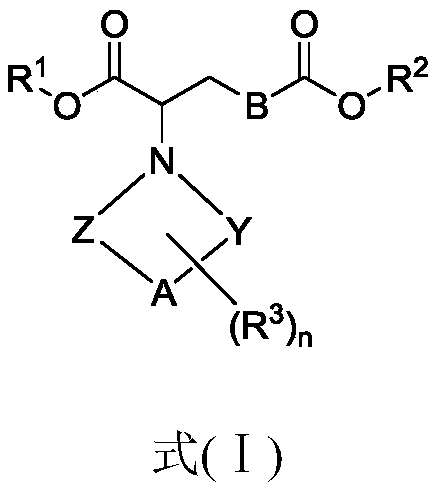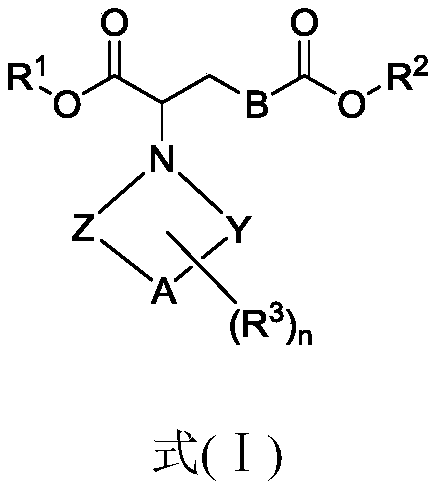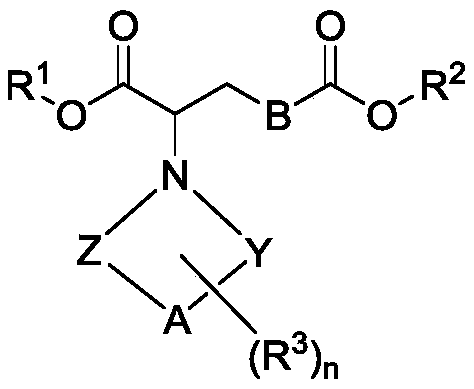Application of 2-cycloamino fatty diacid derivative in preparing animal feed additives
A technology of cyclic amino fats and derivatives, which is applied in the application field of 2-cyclic amino fatty diacid derivatives in the preparation of animal feed additives, can solve the problems such as the use of compounds that are rarely reported, and achieve the goal of improving animal growth and feed remuneration Effect
- Summary
- Abstract
- Description
- Claims
- Application Information
AI Technical Summary
Problems solved by technology
Method used
Image
Examples
Embodiment 1
[0151] Example 1 Effect of 2-cycloamino fatty diacid derivatives on production performance of pigs
[0152] 300 piglets of 65-day-old "Du Dachang" three-way crossbreed lean meat with similar body weight were randomly divided into 10 treatment groups, with 3 replicates in each group, 10 pigs in each replicate, half male and half female. The pigsty and utensils were disinfected before the experiment. During the test period, the pigs were reared in separate pens under the same feeding and management conditions in the same pen. During the test period, the test pigs had free access to food and water, and were fed twice a day. Each test group is the control group (group 1) and test groups 2-10. Among them, the control group was only given the basal diet, and the experimental groups 2 to 10 were given the rations added with 100 ppm of different 2-ring amino fatty diacid derivatives on the basis of the basal diet, as shown in Table 1.
[0153] During the whole feeding process, no o...
Embodiment 2
[0164] Example 2 Effect of 2-cycloamino fatty diacid derivatives on broiler performance
[0165]The experiment adopts a single factor random design, selects 960 three-yellow-feathered broiler chickens with an average body weight of 50 g at the age of 1 day and similar body weight, and randomly divides them into 10 treatment groups, with 6 replicates in each group, half male and half female, and 16 male and female chickens in each replicate. Only three yellow-feathered broilers. The chicken coop and utensils were disinfected before the experiment. During the experimental period, cages were carried out under the same feeding and management conditions in the same chicken house. The basic diet is mainly corn-soybean meal, and no other antioxidant ingredients and growth promoters are added during the whole feeding process. Each test group is the control group (group 1) and test groups 2-10. The control group was only given basal rations, and 50 ppm of different 2-ring amino fatt...
Embodiment 3
[0173] Example 3 Application of 2-cyclic amino fatty diacid derivatives in fish feed
[0174] The fish used in the experiment was grass carp, which was carried out by the Aquatic Farm of Guangzhou Ensaite Experimental Field. Healthy and lively grass carp fingerlings with consistent specifications were raised in large cages for 4 weeks before being used for formal breeding experiments. The experimental system was small floating cages. The small cages and temporary cages are placed in a 3500m test field 2 In the pond, the depth of the pond is about 1.5m, and the pond water is fully aerated bottom water. During the experiment, 420 grass carp that were starved for 1 day were randomly divided into 7 groups, each group had 4 replicates, and 15 fish were placed in each replicate. After the overall weighing, they were randomly put into 28 cages, and fed with different test feeds. . Each test group is the control group (group 1) and test groups 2-7. The experimental feed was self-p...
PUM
 Login to View More
Login to View More Abstract
Description
Claims
Application Information
 Login to View More
Login to View More - R&D
- Intellectual Property
- Life Sciences
- Materials
- Tech Scout
- Unparalleled Data Quality
- Higher Quality Content
- 60% Fewer Hallucinations
Browse by: Latest US Patents, China's latest patents, Technical Efficacy Thesaurus, Application Domain, Technology Topic, Popular Technical Reports.
© 2025 PatSnap. All rights reserved.Legal|Privacy policy|Modern Slavery Act Transparency Statement|Sitemap|About US| Contact US: help@patsnap.com



